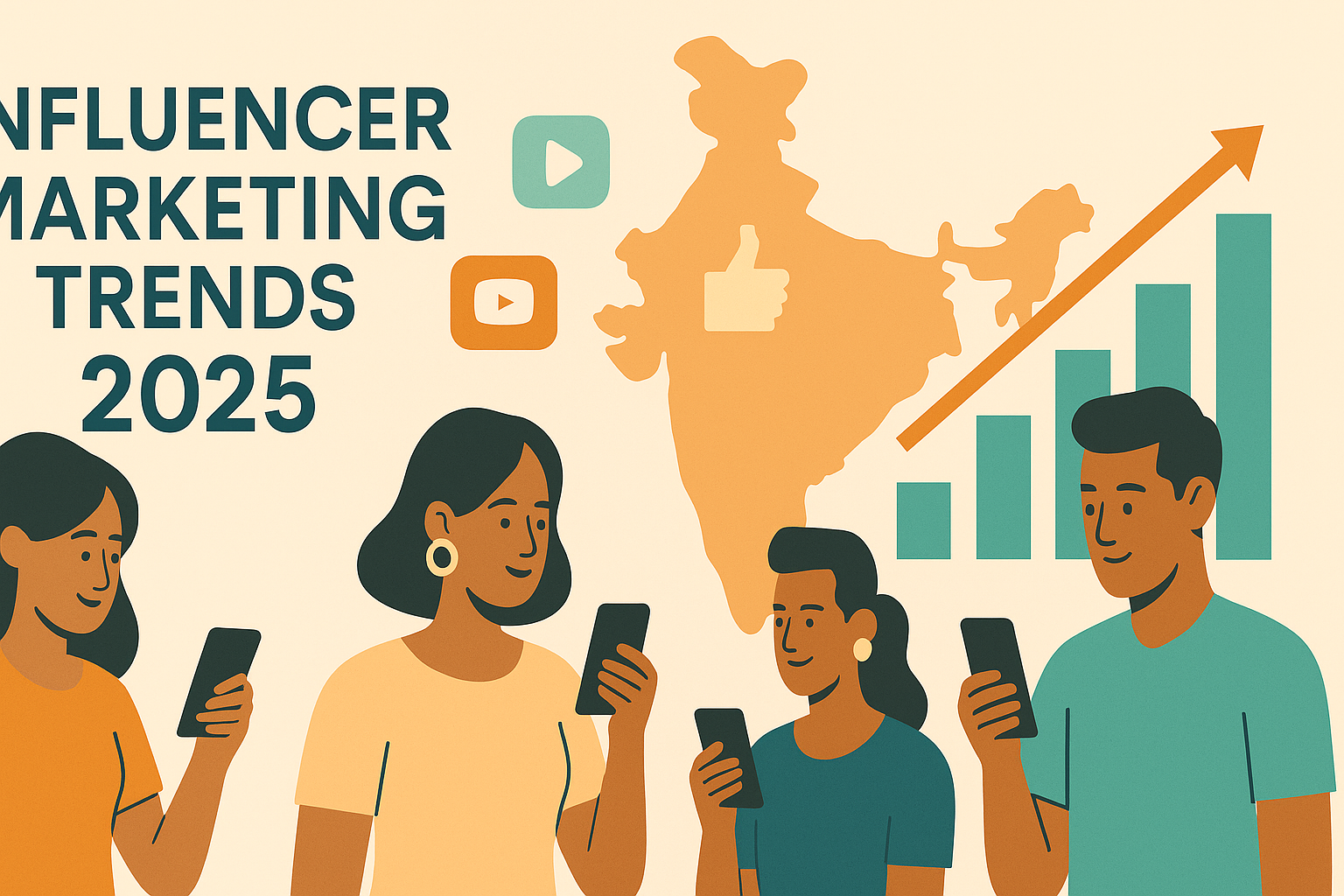Influencer marketing in India has matured from a niche digital tactic into a cornerstone of many brands’ growth playbooks. As we head into 2025, the landscape is more sophisticated—and crowded—than ever before. According to industry projections, India’s influencer marketing spend is set to exceed ₹5,500 crores this year, growing at a 25% annual rate. With nearly 2 million active influencers on Instagram alone, brands must navigate a complex ecosystem of creator tiers, emerging platforms, regional audiences, and evolving regulations. In this deep-dive, we explore the top trends shaping influencer marketing in India for 2025 and offer actionable insights to help marketing professionals, brand managers, startup founders, and agencies stay ahead of the curve.
1. Micro and Nano Influencers: Precision Over Scale
Why Smaller Is Stronger
While celebrity influencers still command massive reach, micro-influencers (10K–100K followers) and nano-influencers (1K–10K followers) are rapidly becoming brands’ preferred partners. Their secret weapon? hyper-targeted, highly engaged communities. Studies show micro-influencers deliver up to 3× higher engagement rates than macro-influencers. For Indian brands, collaborating with 20 micro-influencers can often drive better results than one top-tier celebrity post—at a fraction of the budget.
How to Activate
- Segment by Niche & Locale: Identify micro-influencers whose audience aligns with your product category and geography (e.g., a Bangalore-based fitness coach for a regional workout app).
- Batch Collaborations: Run simultaneous mini-campaigns with 10–30 micro-influencers, then compare performance. This multi-creator approach diversifies risk and maximizes reach across sub-audiences.
- Long-Term Ambassadorship: Convert high-performers into brand ambassadors for ongoing content, deeper storytelling, and authentic product integration.
2. AI and Data-Driven Campaigns
Smarter Discovery
Manual searches and spreadsheets no longer cut it. AI-powered platforms scrape millions of data points—audience demographics, engagement patterns, content quality, growth velocity—to recommend the optimal influencer match for your brand goals.
Predictive Analytics & Optimization
Once campaigns launch, AI continuously analyzes real-time performance metrics (views, saves, comments, click-throughs) to forecast outcomes. If a particular creator or content style under-delivers, AI can suggest in-flight adjustments: reallocate budget, swap in fresh influencers, or tweak messaging for maximum ROI.
Fraud Detection
With India’s influencer space plagued by fake followers and engagement pods, AI’s anomaly-detection capabilities are critical. Platforms can flag irregular spikes in followers or bot-like comment patterns, ensuring you invest only in genuine audiences.
3. Short-Form Video: Reels, Shorts & the Attention Economy
The Rise of Bite-Sized Content
India is now the world’s largest market for Instagram Reels, with over 360 million users engaging daily. YouTube Shorts follows closely, giving creators a powerful avenue to go viral. Short, 15–60-second videos capture attention in a feed-scroll culture—perfect for product demos, quick tutorials, or challenge formats.
Best Practices
- Hook in 3 Seconds: Start with a bold visual or question—“Want flawless skin in 15 secs?”—to prevent scroll-past.
- Native Creativity: Let influencers adapt your brand message to their unique style—dance challenges, lip-syncs, comedy skits—so it feels organic to their followers.
- Silent-View Ready: Over 60% of users watch without sound. Use on-screen text, captions, or visual cues to convey your message even on mute.
4. Social Commerce & Shoppable Content
From Inspiration to Transaction
Social commerce—selling directly within social apps—is exploding. In India, social commerce GMV is forecast to hit $20 billion by 2025. Influencers now tag products in Reels, use affiliate links in Stories, and host live shopping sessions, turning content into a virtual storefront.
Influencer-Led Conversions
- Affiliate Partnerships: Equip influencers with unique discount codes or trackable links. This not only drives sales but provides clear attribution data.
- Live Shopping: Host Instagram Live or YouTube Live events where influencers demo products in real-time and drop “swipe up” links for immediate purchase.
- In-App Shops: Ensure your product catalog is integrated into Instagram/Facebook Shops so users can browse and buy without leaving the app.
5. Authenticity & Long-Term Partnerships
Beyond One-Off Ads
Consumers have become immune to sporadic sponsored posts. 47% of marketers are shifting to long-term influencer partnerships, enabling more natural integrations, deeper storytelling, and genuine advocacy.
Building Lasting Relationships
- Ambassador Programs: Select a core group of influencers to represent your brand year-round, participating in new launches, events, and product feedback loops.
- Co-Creation: Involve influencers in product development—give them early prototypes to test, gather their input, and credit them in launch materials.
- Performance Incentives: Combine fixed fees with performance-based bonuses (e.g., commissions for exceeding sales targets) to align incentives.
6. Regional & Vernacular Content Boom
Over 98% of India’s internet users consume content in regional languages. Brands that localize influencer campaigns into Hindi, Tamil, Bengali, Marathi, and other vernaculars unlock vast Tier 2/3 markets often overlooked by national campaigns.
7. Emerging Tech: AR Filters & Virtual Influencers
Branded Augmented Reality (AR) filters on Instagram let audiences virtually “try on” products—makeup shades, eyewear frames, or themed animations—driving engagement and shareability. Virtual influencers like “Kyra” are also emerging, offering full brand control and 24/7 availability.
8. Data-Driven ROI & Advanced Analytics
Measuring influencer ROI goes beyond likes and comments. Brands integrate UTM-tagged links, affiliate codes, and multi-touch attribution models to map the full customer journey—from first Reel view to cart checkout.
9. Regulatory Compliance & Transparency
Clear disclosure of paid partnerships (“#Ad,” “Paid Partnership with…”) is mandatory. According to ASCI, 69% of top influencers initially failed to disclose properly—brands must educate creators on compliance to avoid fines and reputational damage.
Conclusion & Next Steps
Influencer marketing in India for 2025 is defined by precision, authenticity, and technology. From micro-influencer programs to AI-driven analytics and regional campaigns, brands have a wealth of strategies at their disposal. To streamline your influencer collaborations and gain real-time performance insights, visit Reelax today.

